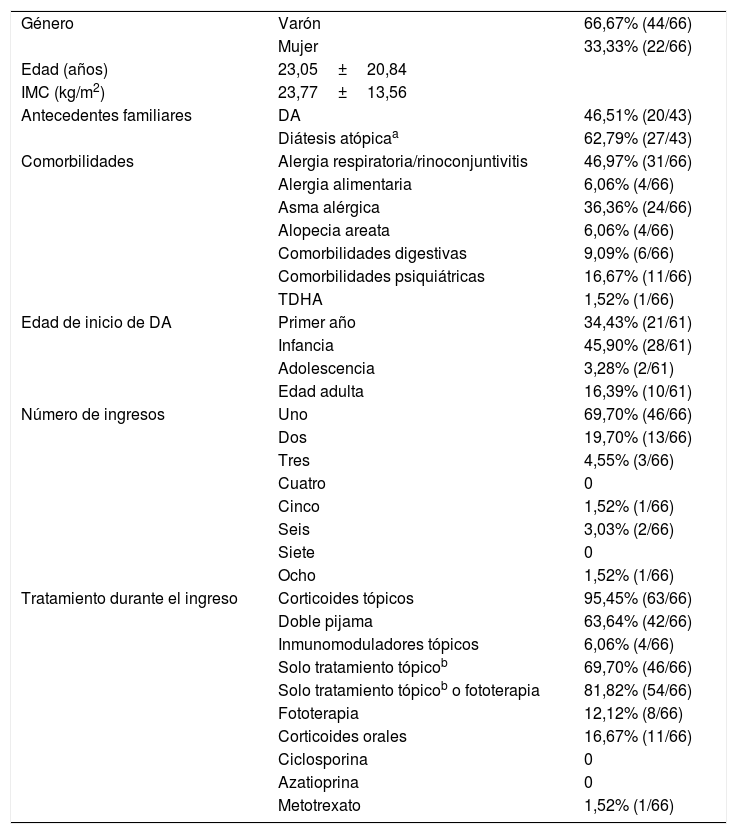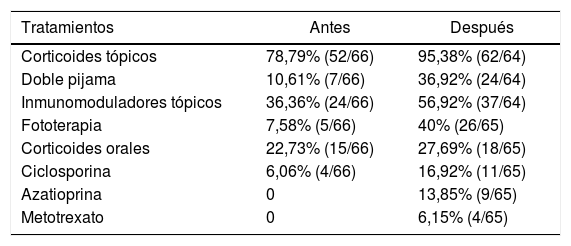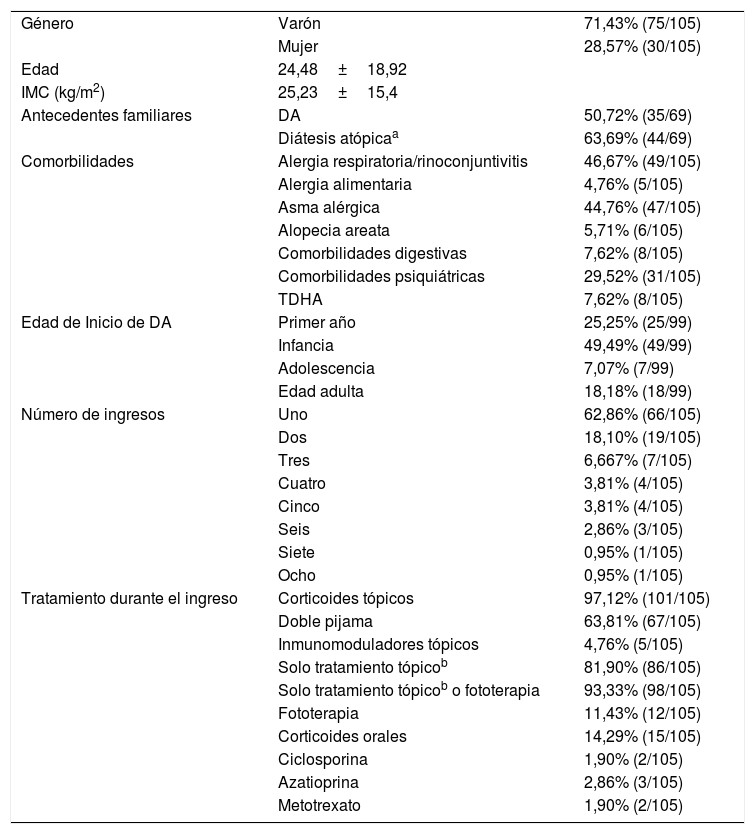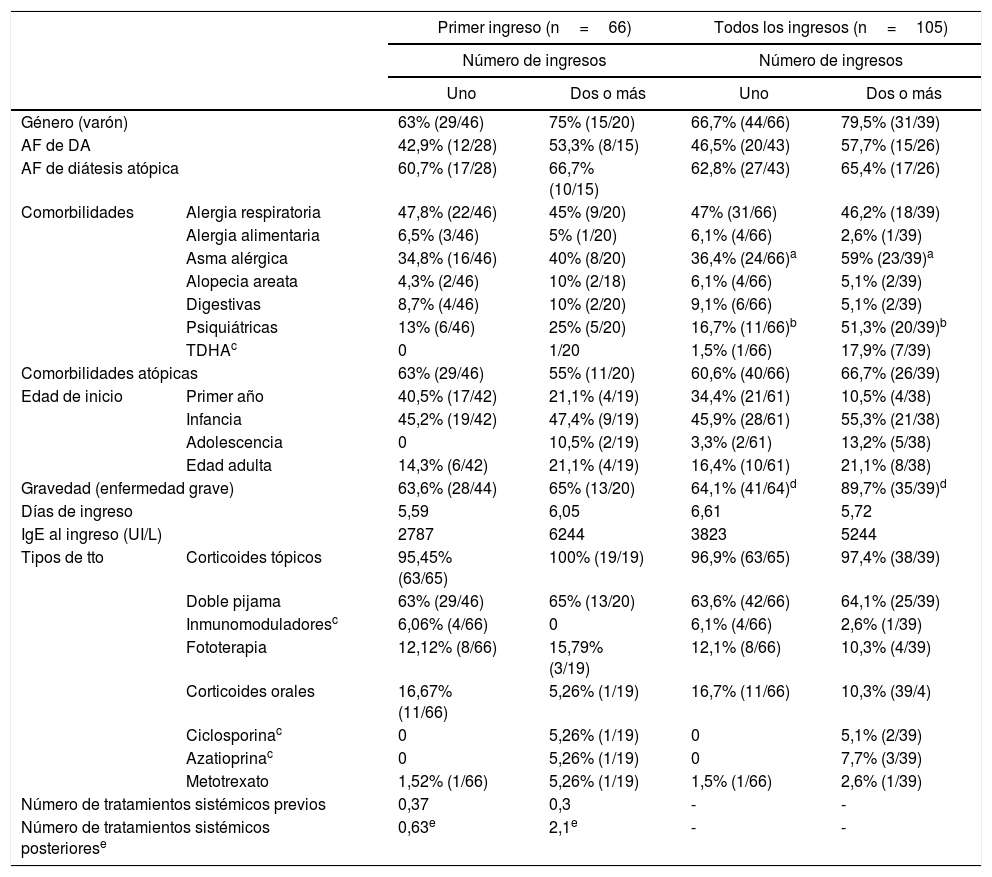Existen pocos trabajos que evalúen los pacientes hospitalizados por dermatitis atópica (DA). Nuestro objetivo principal consistió en describir las características clínico-epidemiológicas de estos pacientes. Secundariamente, se trató de determinar la relación entre la hospitalización y la evolución de la DA.
MetodologíaEstudio descriptivo transversal de los pacientes ingresados por DA en el servicio de dermatología del Complejo Hospitalario Universitario de Pontevedra entre 1999 y 2017.
ResultadosUn total de 66 pacientes (66,7% varones; edad media, 23 años) requirieron ingreso (duración media de 5,7 días). El 60,6% asociaba otras entidades de diátesis atópica, siendo la rinoconjuntivitis la más frecuente (47%). La alopecia areata (6,1%) y las comorbilidades psiquiátricas (16,7%) fueron las asociaciones no atópicas más destacadas. El motivo más frecuente de ingreso fue el brote agudo y generalizado (70,8%), habitualmente grave (64,1%). El tratamiento corticoideo tópico fue el más empleado (95,5%; 63,6% cura húmeda). El 30,3% de los pacientes precisaron 2 o más ingresos, lo que se asoció significativamente a mayor número de tratamientos sistémicos posteriores (p<0,001). Las segundas y posteriores hospitalizaciones se asociaron significativamente a mayor gravedad de los brotes (p=0,004), asma (p=0,024) y presencia de comorbilidades psiquiátricas (p<0,001).
ConclusiónLos pacientes con DA evaluados ingresan predominantemente en la segunda década de la vida debido a brotes agudos y generalizados graves. Durante el ingreso, se manejan mayoritariamente con tratamiento tópico. La hospitalización parece relacionarse con una DA de mayor gravedad. Son necesarios estudios similares con mayor número de pacientes y en distintas poblaciones para confirmar estos hallazgos.
Few studies have focused on patients with atopic dermatitis (AD) requiring admission to hospital. The main objective of this study was to describe the characteristics of these patients with atopic dermatitis. The second aim is to determine the relationship between hospital admission and the clinical outcome of the AD.
MethodologyCross-sectional descriptive study was conducted on patients with AD that were admitted to the Department of Dermatology of the University Hospital of Pontevedra, between 1999 and 2017.
ResultsSixty-six patients (66.7% male, mean age 23 years old) required hospitalization along the study period (mean duration 5.7 days). Atopic associations were present in 60.6% of patients, with rhinoconjunctivitis being the most frequent (47%). Alopecia areata and psychiatric comorbidities were observed in 6.1% and 16.7% of patients, respectively. The main reason for admission was an acute and generalised flare-up (70.8%), of which 64.1% were classified as severe. Topical corticosteroids (95.5%) were the most frequent treatment, with wet-wrap dressings used in 63.6%. More than one admission was required in almost one third of cases (30.3%). The need for two or more admissions was significantly related to a subsequently higher number of systemic treatments (P<.001). Higher flare-up severity (P=.004), asthma (P=.024), and psychiatric conditions (P<.001) were more represented in second or subsequent admissions.
ConclusionIn this study population, patients with AD required admission mostly in the second decade of life, and due to severe acute and generalised flare-ups. In the majority of the cases, the patients only received topical treatment. The need for hospitalisation seems to be related with a more severe AD. Similar studies in a higher number of patients, and including different populations are needed to confirm these findings.












